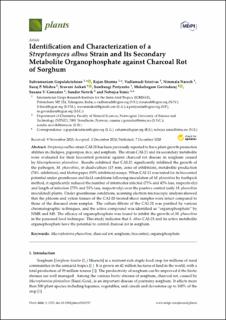| dc.contributor.author | Gopalakrishnan, Subramaniam | |
| dc.contributor.author | Sharma, Rajan | |
| dc.contributor.author | Srinivas, Vadlamudi | |
| dc.contributor.author | Naresh, Nimmala | |
| dc.contributor.author | Mishra, Suraj P. | |
| dc.contributor.author | Ankati, Sravani | |
| dc.contributor.author | Pratyusha, Sambangi | |
| dc.contributor.author | Govindaraj, Mahalingam | |
| dc.contributor.author | Villa Gonzalez, Susana | |
| dc.contributor.author | Nervik, Sondre | |
| dc.contributor.author | Simic, Nebojsa | |
| dc.date.accessioned | 2022-09-01T12:57:10Z | |
| dc.date.available | 2022-09-01T12:57:10Z | |
| dc.date.created | 2021-02-09T10:50:59Z | |
| dc.date.issued | 2020 | |
| dc.identifier.citation | Plants. 2020, 9 (12), . | en_US |
| dc.identifier.issn | 2223-7747 | |
| dc.identifier.uri | https://hdl.handle.net/11250/3015188 | |
| dc.description.abstract | Streptomycesalbus strain CAI-21 has been previously reported to have plant growth-promotion abilities in chickpea, pigeonpea, rice, and sorghum. The strain CAI-21 and its secondary metabolite were evaluated for their biocontrol potential against charcoal rot disease in sorghum caused by Macrophomina phaseolina. Results exhibited that CAI-21 significantly inhibited the growth of the pathogen, M. phaseolina, in dual-culture (15 mm; zone of inhibition), metabolite production (74% inhibition), and blotter paper (90% inhibition) assays. When CAI-21 was tested for its biocontrol potential under greenhouse and field conditions following inoculation of M. phaseolina by toothpick method, it significantly reduced the number of internodes infected (75% and 45% less, respectively) and length of infection (75% and 51% less, respectively) over the positive control (only M. phaseolina inoculated) plants. Under greenhouse conditions, scanning electron microscopic analysis showed that the phloem and xylem tissues of the CAI-21-treated shoot samples were intact compared to those of the diseased stem samples. The culture filtrate of the CAI-21 was purified by various chromatographic techniques, and the active compound was identified as “organophosphate” by NMR and MS. The efficacy of organophosphate was found to inhibit the growth of M. phaseolina in the poisoned food technique. This study indicates that S.albus CAI-21 and its active metabolite organophosphate have the potential to control charcoal rot in sorghum. | en_US |
| dc.language.iso | eng | en_US |
| dc.publisher | MDPI | en_US |
| dc.rights | Navngivelse 4.0 Internasjonal | * |
| dc.rights.uri | http://creativecommons.org/licenses/by/4.0/deed.no | * |
| dc.title | Identification and Characterization of a Streptomyces albus Strain and Its Secondary Metabolite Organophosphate against Charcoal Rot of Sorghum | en_US |
| dc.title.alternative | Identification and Characterization of a Streptomyces albus Strain and Its Secondary Metabolite Organophosphate against Charcoal Rot of Sorghum | en_US |
| dc.type | Peer reviewed | en_US |
| dc.type | Journal article | en_US |
| dc.description.version | publishedVersion | en_US |
| dc.source.pagenumber | 14 | en_US |
| dc.source.volume | 9 | en_US |
| dc.source.journal | Plants | en_US |
| dc.source.issue | 12 | en_US |
| dc.identifier.doi | 10.3390/plants9121727 | |
| dc.identifier.cristin | 1888000 | |
| dc.relation.project | Norges forskningsråd: 226244 | en_US |
| cristin.ispublished | true | |
| cristin.fulltext | original | |
| cristin.qualitycode | 1 | |

